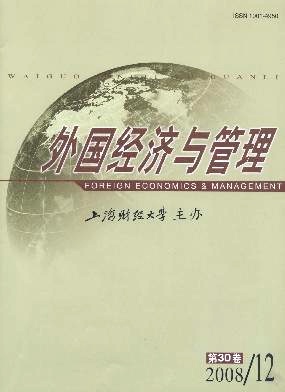试论开放式创新条件下的专属制度内生演化与PFI模型修正
外国经济与管理 2008 年 第 30 卷第 12 期, 页码:10 - 17
摘要
参考文献
摘要
随着时代发展而不断涌现的非常规现象,不仅造就了Teece在1986年提出的创新获利(profiting from innovation,PFI)模型,而且也为我们在开放式创新条件下完善和修正这一重要模型提供了契机。进入21世纪以来,企业创新获利这个问题随着开放式创新的蓬勃发展而更具复杂性和挑战性。本文在PFI模型的基础上,以专属制度内生演化这一非常规现象作为切入点,将多元化的创新主体纳入观察范围,运用组织间关系理论,基于专属制度对互补性资产的杠杆效应进行了嵌套式分析,试图对PFI模型进行探索性修正。
[4]关系型知识产权是受周雪光教授的关系产权研究的启发而提出的。详见:周雪光.关系产权:产权制度的一个社会学解释[J].社会学研究,2005,(1):1-31.
[1]Henderson,R M,and Clark,K B.Architectural innovation:The reconfiguration of exiting product[J].Administrative Science Quarterly,1990,35(1):9-30.
[2]Christensen,C M.Theinnovator’s dilemma:When newtechnologies cause great firms tofail[M].Boston:Harvard Business School Press,1997.
[3]Clark G Gilbert,and Clayton M Christensen.Anomaly-seeking research:Thirty years of development in resource allocation theory[A].in Bower,J L,and Gilbert,C G(Eds.).Fromresource allocation to strategy[C].Greenwich,CT:JAI Press,1999.
[4]Teece,D.Profiting fromtechnological innovation:I mplications for integration,collaboration,licensing and public policy[J].Re-search Policy,1986,15:285-305.
[5]Afuah,A.Innovation management:Strategies i mplementation and profits[M].New York:Oxford University Press,2003.
[6]Chesbrough,H W.Openinnovation:The newi mperative for creating and profitingfromtechnology[M].Cambridge,MA:Harvard Business School Press,2003.
[7]Von Hippel,E.Democratizinginnovation[M].Cambridge,MA:MIT Press,2005.
[8]Benkler,Y.Coase’s Penguin,or,Linux and the nature of the firm[J].The Yale LawJournal,2002,112(3):369-446.
[9]Tapscott,D,and Williams,A D.Wikinomics:How mass collaboration changes everything[M].New York:Penguin,2007.
[10]Boisot,M.Knowledge assets,securing competitive advantage in the information economy[M].Oxford,UK:Oxford University Press,1998.
[11]Sawhney,M,and Prandelli,E.Communities of creation:Managing distributedinnovationin turbulent market[J].California Man-agement Review,2000,42(4):20-54.
[12]Thurow,L C.Anewsystemof intellectual property rights[J].Harvard Business Review,1997,75(5):94-103.
[13]Dosi,G,Marengo,L,and Pasquali,C.How much should society fuel the greed of innovators?On the relations between appropri-ability,opportunities and rates of innovation[J].Research Policy,2006,35:1110-1121.
[14]Laursen,K,and salter,A.Openfor innovation:The role of opennessin explaininginnovation performance among UK manufactur-ing firms[M].Strategic Management Journal,2006,27(1):131-150.
[15]Pisano,G.Profiting frominnovation and the intellectual property revolution[J].Research Policy,2006,35(8):1122-1130.
[16]Bock,G W,and Young-Gul Ki m.Breaking the myths of rewards:An exploratory study of attitudes about knowledge sharing[J].Information Resources Management Journal,2002,15(2):14-21.
[17]David Teece.Reflections on profiting frominnovation[J].Research Policy,2006,35:1131-1146.
[18]Galaskiewicz,J,and Zaheer,A.Networks of competitive advantage[A].in S Andrews,and D Knoke(Eds.).Researchinthe soci-ology of organization[C].Greenwich,CT:JAI Press,1999.
[19]Dyer,J H,and Singh,H.The relational view:Cooperative strategy and sources of interorganizational competitive advantage[J].Academy of Management Review,1998,23(4):660-679.
[20]Chesbrough,H.Open business models:How to thrive in the newinnovation landscape[M].Boston:Harvard Business School Press,2006.
[1]Henderson,R M,and Clark,K B.Architectural innovation:The reconfiguration of exiting product[J].Administrative Science Quarterly,1990,35(1):9-30.
[2]Christensen,C M.Theinnovator’s dilemma:When newtechnologies cause great firms tofail[M].Boston:Harvard Business School Press,1997.
[3]Clark G Gilbert,and Clayton M Christensen.Anomaly-seeking research:Thirty years of development in resource allocation theory[A].in Bower,J L,and Gilbert,C G(Eds.).Fromresource allocation to strategy[C].Greenwich,CT:JAI Press,1999.
[4]Teece,D.Profiting fromtechnological innovation:I mplications for integration,collaboration,licensing and public policy[J].Re-search Policy,1986,15:285-305.
[5]Afuah,A.Innovation management:Strategies i mplementation and profits[M].New York:Oxford University Press,2003.
[6]Chesbrough,H W.Openinnovation:The newi mperative for creating and profitingfromtechnology[M].Cambridge,MA:Harvard Business School Press,2003.
[7]Von Hippel,E.Democratizinginnovation[M].Cambridge,MA:MIT Press,2005.
[8]Benkler,Y.Coase’s Penguin,or,Linux and the nature of the firm[J].The Yale LawJournal,2002,112(3):369-446.
[9]Tapscott,D,and Williams,A D.Wikinomics:How mass collaboration changes everything[M].New York:Penguin,2007.
[10]Boisot,M.Knowledge assets,securing competitive advantage in the information economy[M].Oxford,UK:Oxford University Press,1998.
[11]Sawhney,M,and Prandelli,E.Communities of creation:Managing distributedinnovationin turbulent market[J].California Man-agement Review,2000,42(4):20-54.
[12]Thurow,L C.Anewsystemof intellectual property rights[J].Harvard Business Review,1997,75(5):94-103.
[13]Dosi,G,Marengo,L,and Pasquali,C.How much should society fuel the greed of innovators?On the relations between appropri-ability,opportunities and rates of innovation[J].Research Policy,2006,35:1110-1121.
[14]Laursen,K,and salter,A.Openfor innovation:The role of opennessin explaininginnovation performance among UK manufactur-ing firms[M].Strategic Management Journal,2006,27(1):131-150.
[15]Pisano,G.Profiting frominnovation and the intellectual property revolution[J].Research Policy,2006,35(8):1122-1130.
[16]Bock,G W,and Young-Gul Ki m.Breaking the myths of rewards:An exploratory study of attitudes about knowledge sharing[J].Information Resources Management Journal,2002,15(2):14-21.
[17]David Teece.Reflections on profiting frominnovation[J].Research Policy,2006,35:1131-1146.
[18]Galaskiewicz,J,and Zaheer,A.Networks of competitive advantage[A].in S Andrews,and D Knoke(Eds.).Researchinthe soci-ology of organization[C].Greenwich,CT:JAI Press,1999.
[19]Dyer,J H,and Singh,H.The relational view:Cooperative strategy and sources of interorganizational competitive advantage[J].Academy of Management Review,1998,23(4):660-679.
[20]Chesbrough,H.Open business models:How to thrive in the newinnovation landscape[M].Boston:Harvard Business School Press,2006.
引用本文
王雎. 试论开放式创新条件下的专属制度内生演化与PFI模型修正[J]. 外国经济与管理, 2008, 30(12): 10–17.
导出参考文献,格式为:
下一篇:组织理论认知观评介





 5211
5211  560
560

